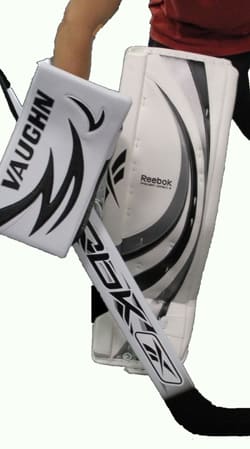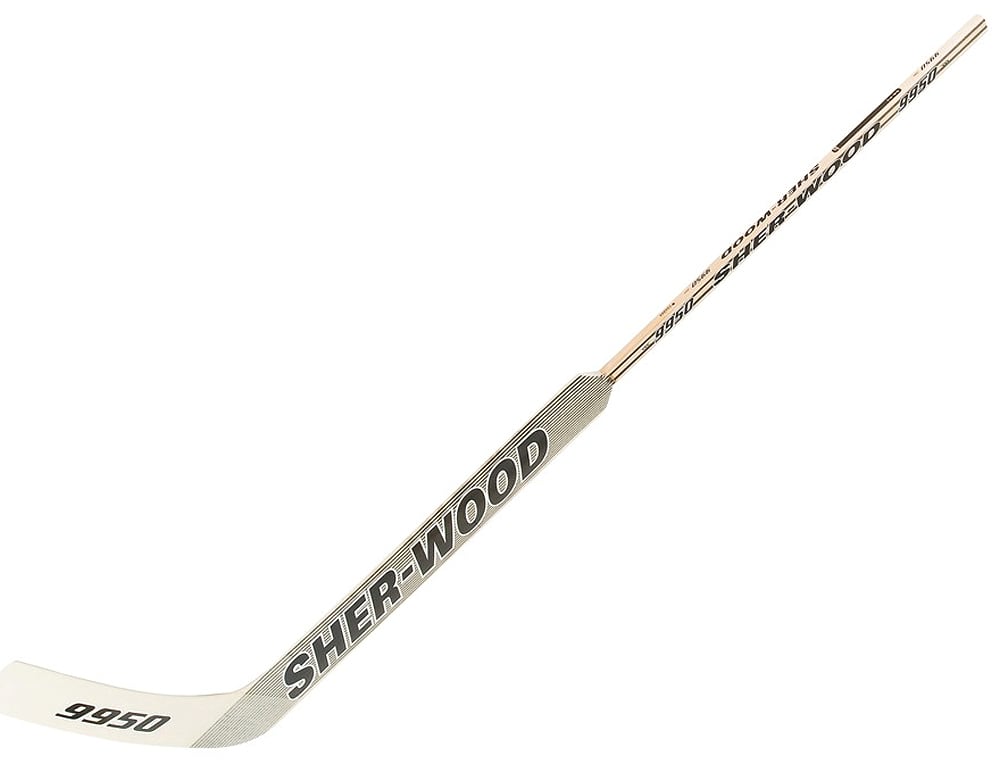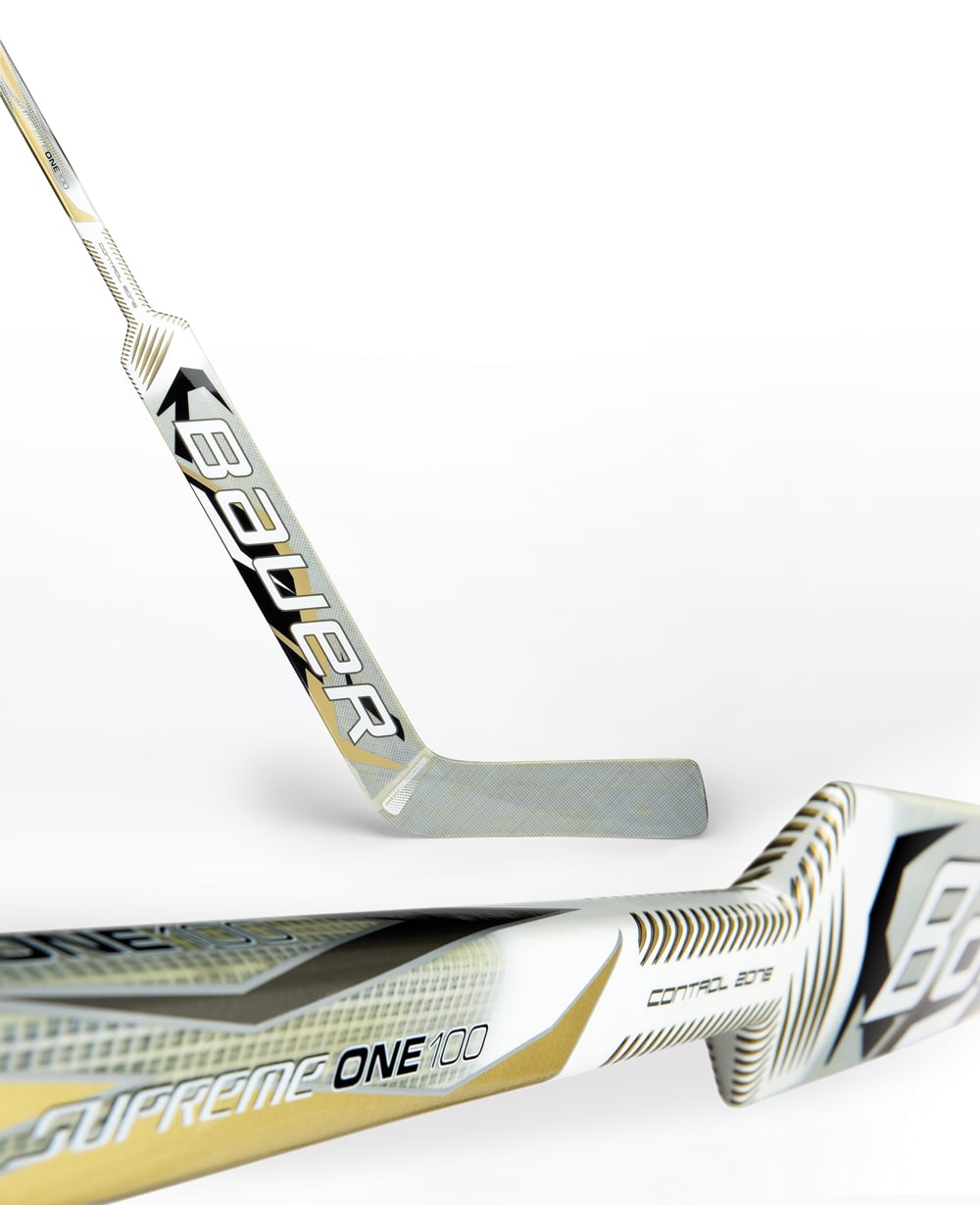What Size Of Hockey Stick Do I Need
Finding a goalie's correct stick length is crucial, though its importance is often disregarded with younger goaltenders. When measuring for the correct size, recollect that the length of the paddle (the thicker part of the goal stick) is the nigh important feature.
The right paddle length helps the goalie maintain a proper opinion. The paddle must be long enough so that when the goalie is in the proper opinion with their knees bent and stick flat on the ice 8" to 12" in front of their toes, the blocker is aligned with the leg pad and is non overlapping the leg pad.
To properly fit a goalie stick, follow these elementary steps:
| 1. Put on goalie skates if at all possible. Street shoes won't accurately simulate playing weather condition, and your fitting volition non exist accurate. 2. Have the goalie make it a stance position as if he/she was playing - knees bent, hands in front of the torso, stick 12" from the skates. A perfectly fit stick will place the goalie's blocker next to his or her leg pad, as shown in the picture to the right. The stick is too short if the blocker overlaps the leg pad, or if the heel of the stick comes off of the water ice in a normal stance position. The stick is too big if there is a large gap between the blocker and the leg pad, or if the toe of the stick comes off the ice in a normal opinion position. |  |
CHOOSING A GOALIE STICK PATTERN
Given today's emphasis on goalies playing the puck, information technology is more than important than ever to consider the bract pattern of the goalie stick. Don't simply buy the lightest, cheapest stick on the rack—know your individual needs and style, and purchase a stick based on these attributes.
The "Pattern" of a stick describes two elements: the curve of the blade and the lie of the stick.
one. CURVE
The bend is based on two dissimilar attributes: where the curve begins in the stick ("Mid" or "Heel"), and how the confront of the blade is positioned, moving from the heel of the stick to the toe of the stick ("Open" or "Closed"). Understanding these options and their merits will help yous make the all-time purchasing determination.
Bend Blueprint Descriptions:
- Mid Bend - curvature begins in the middle of the blade.
- Heel Bend - curvature starts at the heel of the blade.
- Open up Curve - bract flares open up equally the bend approaches the toe (think of a wedge in golf).
- Airtight Curve - bract stays more apartment throughout the curve (think of a three-fe in golf).
Equally a general rule, sticks with a mid bend brand information technology easier to play the puck but a flake more challenging to shoot the puck higher.
Sticks with a more open bend, especially an open heel bend, make it easy to clear a puck high off of the glass only a bit harder to play around the net.
Start GOALIES should start with a MID curve and so suit from hither, if necessary, based on their fashion.
ii. STICK LIE
The lie of the stick describes the location of the paddle when the stick bract is flat on the ice. By and large, nosotros advise that the blocker exist simply to the side of, and not overlapping, the leg pad when the goalie is in his/her stance. Depending on their stance, goalies may need to purchase a stick that has a lower (thirteen) or higher (15) lie.
Choosing the proper stick prevarication is critically important, equally it affects more just the blocker board position in the goalie'due south stance. Shooting, directing the puck upon impact, etc., are all afflicted past the stick lie. Therefore, it is important that the goalie wear his/her skates when picking a new stick to ensure an accurate fit.
Lie 13: Places the blocker board farther away from the body with the stick blade flat on the ice.
Lie 14: Mid-level lie
Prevarication xv: Places the blocker board closer to the body with the stick blade flat on the ice.
Notation: Lie measurement only applies to sticks with a flat blade bottom. Sticks with a curved or rockered blade bottom have no lie listed.
CONSIDERING FLEX WHEN Ownership A STICK
Stick flex is a mensurate of how flexible or how stiff a hockey stick is when a force is applied to it. Again, since passing and shooting the puck take go critical skills for today's goalies, it'southward important that the goalie choose a stick flex that all-time fits his or her needs.
When a role player takes a shot, the hockey stick bends—which essentially turns the hockey stick into a leap that stores energy. When the spring is released (when the stick unbends and returns to straight), the energy is released and accelerates the puck.
"Strong" sticks are harder to flex, but the energy released when the stick returns to form is greater. For this reason, stronger or heavier players may wish to use a stick with a strong flex. Younger or weaker shooters will not be able to take advantage of the energy recoil of strong sticks because they can't curve them in the showtime place.
More flexible sticks are easier to bend, but they release less energy as the stick recoils. A softer flex therefore makes shooting easier for younger, weaker shooters. Stronger shooters will discover that these sticks bend besides much and their shooting accuracy suffers.
WHAT ARE THE DIFFERENT TYPES OF STICKS?
Goalie sticks come in three unlike types:
| 1. Wood GOALIE STICKS Forest sticks are typically made of laminated pieces of aspen, ash, or birch, which are covered on the paddle and blade by sparse layers of fiberglass for durability and water resistance. As stick engineering science has advanced in the last few decades, the need for woods sticks has decreased. Today'due south goalies tend to favor lighter and softer models. Goalies who adopt a more traditional feel, or who are on a budget, will find forest sticks appealing. |  |
| two. FOAM CORE GOALIE STICKS Foam core sticks typically feature a forest shaft with a glass lamination for durability. The paddle and blade are made from a molded urethane, which is and so injected with cream and covered with a glass or composite laminate for forcefulness and water resistance. Newer foam cadre sticks also characteristic a harder heel insert to keep the heel from premature clothing and tear. The foam inside the paddle and blade provide rigidity and dampen the vibrations that goalies feel when the puck hits the stick. Oftentimes, goalies who utilise a foam core stick will depict its experience as "soft," meaning that there is little vibration from puck bear upon. Foam cadre sticks take grown in popularity over the years as they combine a reasonable toll betoken, a light weight, a soft experience, and good durability. |  |
| 3. Composite GOALIE STICKS Today'southward composite sticks are made from a variety of materials, ranging from fiberglass to graphite to carbon fiber/Kevlar. Like cream cadre sticks, composite sticks often feature cream core injections for vibration deadening, and they are often wrapped in higher grade constructed materials similar nylon, carbon fiber, or Kevlar, which assistance promote durability. Due to the nature of their materials, composite sticks—particularly the carbon fiber, Kevlar, and graphite models—tend to be the lightest on the market place. Additionally, many of today's models feature innovative elements including "rubbery" grip zones on the shoulder area, convex or apartment paddle profiles (on the side that faces the shots), and contoured paddles that arrange goalies who like to hold the stick closer to the trunk. Composite sticks tend to be the nearly expensive on the market, though buyers may take some comfort in knowing that many of today'south composites characteristic a 30-day manufacturer's warranty. |  |
What Size Of Hockey Stick Do I Need,
Source: https://goalie.purehockey.com/c/goalie-stick-sizing
Posted by: kennedyenone1944.blogspot.com


0 Response to "What Size Of Hockey Stick Do I Need"
Post a Comment